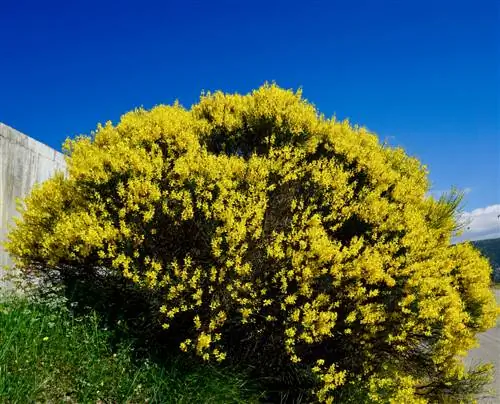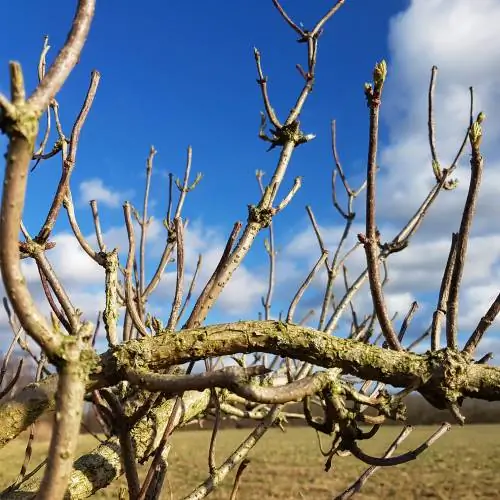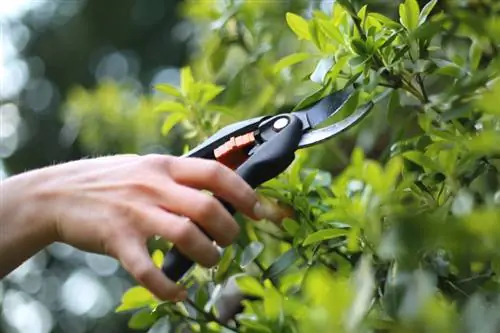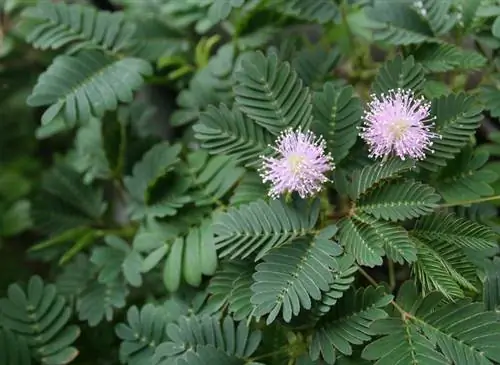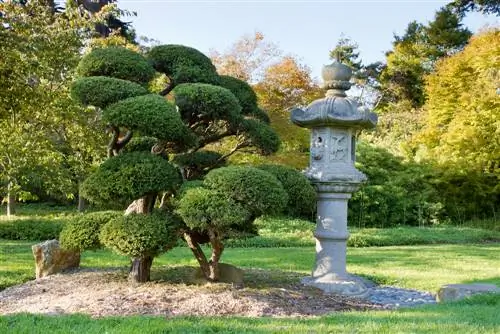- Author admin [email protected].
- Public 2023-12-24 06:09.
- Last modified 2025-06-01 06:02.
The genus Genista gives us bright yellow ornamental shrubs that transform the garden and balcony into a floral fairytale. Well-known species are Dyer's gorse, winged gorse and Goldland gorse, which reach heights of between 40 and 100 centimeters. We owe majestic broom bushes up to 2 meters high, such as broom broom or ivory broom, to the genus Cytisus. Although both genera look very similar and their flowering times overlap, they differ in terms of pruning care. This tutorial explains the right gorse cut at the best time and points out important differences.
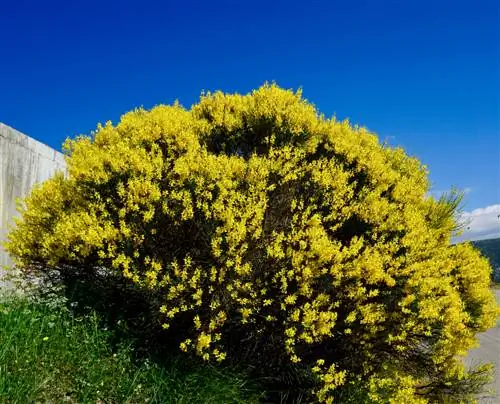
When should you cut gorse?
After winter, cut the gorse. They remove brown and dead plant parts. The perfect time for this is in spring. Often some shoots fall victim to frost and can be removed before flowering.
Groom thrives uncut in the natural garden
Thanks to their early flowering time of the year, all broom bushes are a welcome source of food for bees, bumblebees and butterflies. The ornamental trees shine in all their splendor when valuable pollinator insects rely on nutritious nectar after their winter rest in order to gain strength to build up their colonies. For ecologically oriented gardeners, broom bushes are part of the basic equipment when creating a natural garden.
In thenatural gardengorse bushes of both genera are allowedgrow freelyThe reason for the gardening decision is that the trees are not particularly tolerant of pruning. Either it is cut every year or not at all. The trees no longer sprout from old wood. An annual cut promotes the growth of young shoots, but results in an unnatural, formal shape. Uncut broom develops anatural habit with high utility value for insects and birds. At the same time, the bushes sow themselves. Since gorse species are short-lived trees, some seedlings are simply spared when weeding. If the parent plants die, the offspring will have long since filled the resulting gap.
Gross cutting at a glance - all cutting types and dates
You can't identify real broom only by its golden yellow flower clusters. In contrast to broom broom or noble broom of the Cytisus genus, which also blooms up to 2 meters high, real broom bushes remain well below 100 meters tall. Another indication of the correct pruning at the best time is the flowering time. Spring-flowering Cytisus speciesbloom onprevious year's woodand are pruned immediately after flowering. Summer-flowering Genista species bloom onthis year's shoots and are cut in early spring. If you are not familiar with the botanical classification of your broom, you can decide which cutting types and dates in the following table apply to your flowering shrub based on the height and flowering time:
| Cut style | Broom type (average height) | Flowering time | best date |
|---|---|---|---|
| Plant cutting | all gorse | irrelevant | immediately after planting |
| Conservation cut | Real gorse etc. (40 to 80 cm) | May/June to August/September | every year in February |
| Conservation cut | Broom broom etc. (100 to 200 cm) | April/May to June/July | every year after the flowering period |
You will look in vain for an appointment for the rejuvenation cut in this table. Gorse does not tolerate cutting into old wood. For this reason, pruning of broom bushes only has a chance of success if it begins on the day of planting and is carried out every year.
For a better understanding of this tutorial, the relevant broom types will not be listed again below. Real gorse includes cutting for all Genista species, such as dyer's gorse, winged gorse, Goldland gorse and sand gorse. Broom broom represents species of the genus Cytisus, such as ivory broom and noble broom as well as varieties derived from them.
Pruning encourages broom to branch vigorously
The pruning care of broom bushes begins onPlanting day The aim of a plant pruning is to motivate the young tree to branch densely from below. The following cut applies to both gorse and varieties as well as broom and varieties:
- Immediately after planting, cut back all shoots to a height of 10 to 15 centimeters
- Short bare-rooted goods by at least half, potted goods by at least a third
- Cut off damaged and noticeably weak shoots at the base
- Examine bare-rooted young bushes for damaged roots in order to cut them out
You give the flowering bush a decorative, hemispherical shape when you cut at different depths. Shorten outer shoots to 10 centimeters, while shoots in the center are cut to 13 to 15 centimeters.
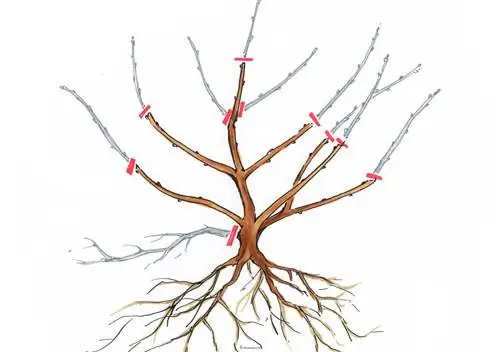
Short all shoots on bare-rooted trees by half so that they branch lushly. On pots and containers, cut back strong shoots by a third and only the weak branches by half.
Background
Pruning redirects sap pressure to the base
In every broom bush, the sap pressure acts as a control center for growth. The floral direction is towards light in order to be ahead in the competition with plant neighbors. Consequently, the largest proportion of the reserve materials heads for theSpitzenbudsThis is where thestrongest growth takes place. This applies equally to the plant itself and to each individual shoot. The greater the distance between a bud and the tip position, the lower the sap pressure and weaker the growth. When pruning, cut all shoots in half. Previously subordinate buds become the new top. The intensified sap pressure causes increased growth, so that a young bush sprouts vigorously at the base and branches densely.
Cut real gorse vigorously every year - instructions for maintenance cutting
Real gorse is blooming on this year's shoots. Perennial wood is a hindrance to the summer blossom festival and should be removed every spring, as illustrated in the figure below. This is how you get the perfect maintenance cut:
- The best time is in February (at the latest by the beginning of March)
- Put on gloves, eye protection and long-sleeved clothing
- Cut the entire bush back to a height of 10 centimeters
Following the maintenance cut, fertilize with mature compost and horn shavings. As a rule, a one-time starter fertilization covers the nutrient requirements for the season. Pamper potted plants with a long-term fertilizer in granules or sticks. Alternatively, apply a liquid fertilizer every 4 weeks from the beginning of March until the end of August.
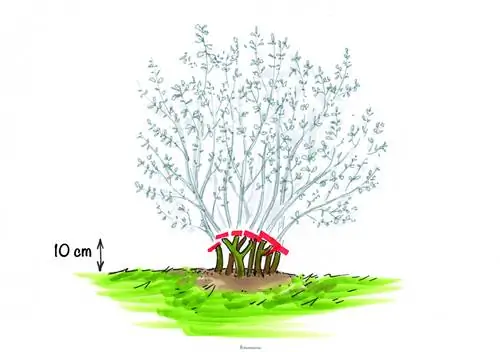
Every year in February cut back all shoots to 10 centimeters. Real gorse cannot tolerate a cut into old wood. For this reason, prune annually.
Background
Do maintenance pruning before the start of the breeding season
When blackbirds, chaffinches and chiffchaffs open this year's breeding season in March, all pruning work on trees must be finished. According to the Federal Nature Conservation Act, theclosed seasonfor nesting birds extends from1. March to September 30th, so that bullfinches, dunnocks and wrens can finish their breeding business in peace. Radical pruning measures, such as planting on the bush, are permitted between October 1st and February 28th, as long as there are no wild animals in the bush or tree. As an exception, the legislature allows light maintenance cuts during the grace period, provided they are limited to the current growth.
Moderate maintenance pruning of broom gorse - this is how you prune correctly
Broom broom blooms on theannual shoots The shrub produces its buds the previous year. Pruning in spring would therefore destroy all hopes of opulent spring blossoms. With careful pruning, you can still keep the ornamental tree in shape, provided you use scissors every year. As the figure below shows, maintenance pruning also pursues the goal of continuous rejuvenation. How to do it correctly:
- The best time is immediately after the flowering period
- Check the shrub for nesting birds and prune at a later date if necessary
- Put on gloves, safety glasses and long-sleeved clothing
- From the 4th year onwards, thin out the 3 oldest ground shoots in exchange for 3 young ground shoots
- Leave branches that are too long on a side shoot 40 to 50 centimeters high
Although you cut broom broom after flowering, it also receives a generous portion of compost with horn shavings. While this year's flowers wither, the plant lays buds for the coming year. Additional nutrients come in handy.
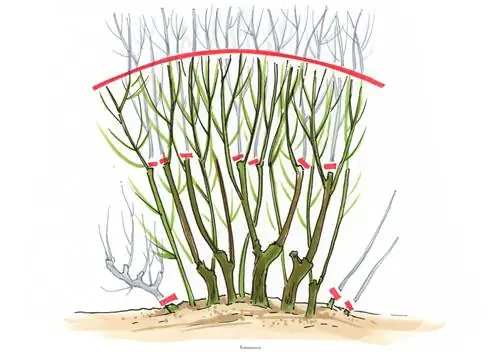
Starting in the fourth year, replace the three oldest ground shoots with young shoots. Direct any remaining ground shoots onto a young side shoot 40 to 50 centimeters high.
Excursus
Derive gorse branches instead of just cutting them off
Dedicate yourself to pruning a broom that is too large, do not cut the relevant branches anywhere. To ensure that a cut does not leave unsightly gaps, we recommend the derivation cut. The aim of this effective cutting technique isslimming instead of shortening. To do this, look for a young side shoot on the branch in question at a height of 40 or 50 centimeters. Place the scissors where the old branch and the young side shoot fork. The young wood now takes over the leadership position, without any gap becoming visible in the overall picture.
Aging, old gorse bush - what to do?
Acut into old woodis taboo on all broom bushesRegardless of their botanical affiliation, flowering time or height, the trees consistently refuse to do this Growth if you intersect perennial shoots. The logical consequence is to clear the striking gorse in order to plant a young bush in its place. Before you discard the once magnificent spring or summer bloomer, please give it one last chance. The following ideas for the floral rescue plan are based on two alternative conditions: there are no young ground shoots present - some young ground shoots are still thriving. Be inspired by our suggestions:
No young ground shoots available
If a real broom or broom has not been cut for many years, there are often no soil-borne young shoots left. Putting the old gorse bush on the stick is not a solution, because no growth can be expected from old wood. Shoot stubs simply dry back. Outdated ground shoots that are bare at the bottom sometimes have a vital, green area in their upper half.
If the broom bush in question hangs casually over a wall or wooden fence, it still has a certain charm. Care for the green heads as if they were your own plant and leave the lower bare area as it is.
At least two or three young ground shoots present
Under ideal site conditions, young, unbranched ground shoots thrive on aged gorse. This offspring forms a perfect starting point for the new development. First, cut off all old, bare ground shoots at the base or to short cones. The best time is in early spring, shortly before budding begins. The path to light is no longer blocked for the young ground shoots, so that vigorous growth begins. Fertilize the rejuvenated shrub generously with compost and horn shavings. Subsequently, carry out consistent, species-appropriate pruning care according to the instructions in this tutorial.
Frequently asked questions
Is gorse poisonous?
All types of broom contain toxic substances, such as the alkaloid sparteine or the toxin cytisine. Toxins are found in the highest concentration in the seeds. Consuming 5 to 10 seeds is enough for children to suffer from nausea and vomiting. If large quantities of leaves and seeds enter the human organism, there is a risk of serious he alth problems such as circulatory failure and heart collapse. Horses, cows, sheep, dogs, cats and fish react with typical symptoms of poisoning when they eat parts of broom bushes. The cultivation of gorse should be avoided in the family garden or the children should be made urgently aware of the dangers.
I haven't blended my yellow gorse (Cytisus scoparius) yet. The shrub has now developed two main shoots that are 2.5 meters high and slightly overhang. There's a gap in the middle that I don't like at all. Can pruning fix the problem?
Cutting yellow gorse is very tricky because the bush sprouts poorly after a strong cut into the old wood. The best prospects for a topiary are young plants that you cut regularly from the start and thus keep compact. Now it's most likely too late. If you no longer like the gorse, you should clear it. Before doing so, it would be worth trying to cut back by half or two thirds and wait and see what the reaction is.
What is the difference between common broom and noble broom? Both species come from the genus Cytisus
The common broom is the native wild form. If you come across a gorse bush on your walks in the fields and forests, it is usually this yellow-flowering type of gorse that can grow up to 2 meters high. Noble gorse, on the other hand, is the result of breeding or natural mutation. Here you can choose from various varieties with a variety of flower colors. Gorse blooms white, yellow, apricot, red or two-tone.
Can I keep an ivory broom (Cytisus praecox 'Allgold') smaller at 50 centimeters than the 100 to 150 centimeters it normally reaches?
This is certainly possible, but requires annual pruning. An ivory broom blooms on annual wood, so it is cut after the flowering period. Since it hardly or not at all sprouts from old wood, you should cut shoots back to the desired height every year.
Is broom hardy?
Planted broom bushes are completely hardy. Nevertheless, we recommend light protection with leaves and brushwood during the planting year, as young plants still have to develop their frost hardiness. In the pot, however, all broom bushes require winter protection. Cover the container with bubble wrap and place it in a protected niche on wood or Styrofoam.
Can parts of the cuttings be used as cuttings for propagation?
The most promising method of propagation is sowing seeds. Propagation from cuttings is possible, but is associated with a high failure rate. Use 15 centimeter long, herbaceous and non-flowering branch tips, defoliating the lower half. Then fill pots with growing substrate and place 2 to 3 cuttings two-thirds of the way in. A transparent cover placed over the plant promotes rooting. Keep the substrate constantly slightly moist. Plant rooted cuttings directly into the sunny bed.
I received a gorse tree as a gift. What should you pay attention to when cutting?
The pruning care of tall stems and shrubs does not differ significantly. If it is a true broom of the Genista genus, cut the crown back to 5 to 10 centimeters every spring. This is followed by vigorous growth of fresh shoots on which the sunshine-yellow flowers unfold. If you have been gifted with a standard broom stem from the Cytisus genus, cut the crown back by half to two thirds after the flowering period. In contrast to broom bushes in the bed, a little more pruning should be done to keep the crown compact and blooming.
I planted cushion broom (Cytisus decumbens) as a ground cover in my rock garden? Do I have to cut the bushes?
Pillow broom grows 10 to 20 centimeters high, with an average annual growth of 5 centimeters. Densely bushy and full of flowers, the plant thrives without any pruning measures.
The 3 most common cutting mistakes
If a gorse bush refuses the longed-for blossoms, grows old into a bare bush or dies completely, it cannot be a coincidence. In fact, this is how typical oversights in pruning care become apparent. The following table informs you about the three most common cutting errors and provides tips for expert prevention:
| Cutting errors | malicious image | Prevention |
|---|---|---|
| wrong cutting time | Failure of flowering period | Real broom in February, cut broom broom after flowering |
| never photographed | increasing baldness from the inside out, premature aging | Thin out real gorse regularly and replace the oldest ones with young ground shoots on brooms |
| put on the stick | no more growth | do not cut into old wood, no rejuvenation cut |
Tip
With regard to their location preferences, there is an important difference to note between common broom and broom. True broom species and varieties prefer fresh to moderately moist and nutrient-rich soil. Broom species and varieties develop optimally in dry, often sandy and poor soil.

